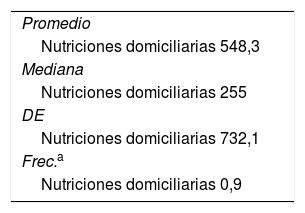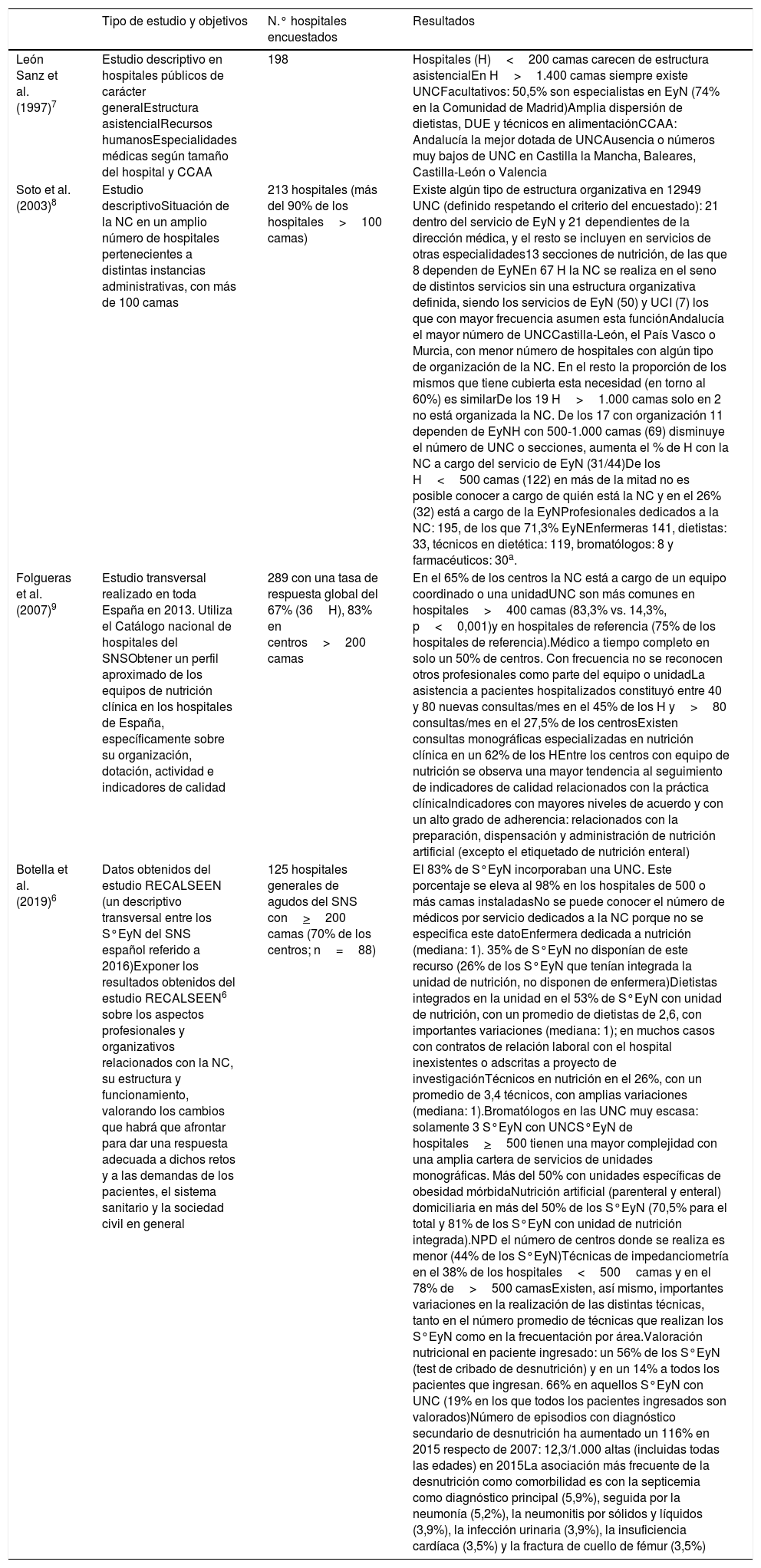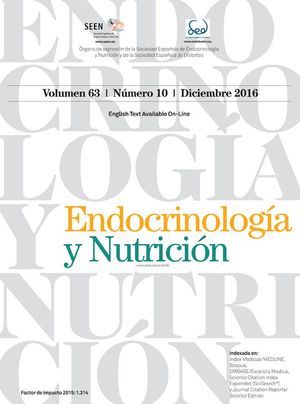La nutrición artificial (NA) es uno de los ejemplos más representativos de programas terapéuticos coordinados, lo que hace necesario su desarrollo y adecuada organización. Las primeras unidades de nutrición clínica (UNC) surgen en los hospitales públicos del Sistema Nacional de Salud (SNS) en la década de 1980-1990 y se han ido incorporando progresivamente a los servicios de endocrinología y nutrición (S°EyN). El objeto de nuestro artículo es exponer los resultados obtenidos del estudio RECALSEEN sobre los aspectos profesionales y organizativos relacionados con las UNC, su estructura y funcionamiento.
Material y métodosLos datos se han obtenido del estudio RECALSEEN, que es un estudio descriptivo transversal entre los S°EyN del SNS español referido a 2016. La encuesta se recogió de marzo a septiembre de 2017. Las variables cualitativas se describen con su distribución de frecuencias (número de casos y porcentajes) y las variables cuantitativas con la media, mediana y desviación estándar.
ResultadosSe han obtenido 88 (70%) respuestas de S°EyN sobre un total de 125 hospitales generales de agudos del SNS con 200 o más camas instaladas. El 83% de S°EyN incorporaban una UNC (98% en los hospitales de 500 o más camas). Como mediana los S°EyN tienen una enfermera dedicada a nutrición (35% no disponían de este recurso). El 53% de S°EyN con unidad de nutrición tenían dietistas integrados en la unidad (mediana: 1).
Los S°EyN situadas en hospitales de 500 o más camas tienen una mayor complejidad, con una amplia cartera de servicios de unidades monográficas (obesidad mórbida —78,3%—, nutrición artificial domiciliaria —87%—, enfermedades crónicas —65,2%—) y de técnicas específicas (impedanciometría —78%—). Sin embargo, solo se realiza un test de cribado universal de desnutrición en el 14% de los centros, y el diagnóstico secundario de desnutrición únicamente aparece en 12,3 informes por cada 1.000 altas hospitalarias.
DiscusiónTras los estudios de 1997 y 2003 los resultados de 2017 arrojan un notable crecimiento y consolidación de las UNC dentro de los S°EyN de la mayoría de los hospitales. Actualmente, el crecimiento de la especialidad pasa en buena medida por la demanda asistencial que crea la nutrición clínica hospitalaria. La dotación de personal de enfermería y de dietistas-nutricionistas en las UNC sigue siendo insuficiente y, en este último caso, son frecuentes los contratos atípicos, o becas financiadas por proyectos de investigación o por la industria farmacéutica. La presencia de unidades para enfermedades nutricionales específicas, y la participación en grupos multidisciplinares, bastante heterogénea, se concentra en hospitales de 500 o más camas y constituye una excelente oportunidad de desarrollo para las UNC.
ConclusionesLa incorporación de UNC en los S°EyN es amplia en los hospitales de España, y la asistencia se realiza por endocrinólogos que dedican la mayor parte de su tiempo a la nutrición clínica en más de la mitad de los hospitales. Esta circunstancia es más común en centros grandes, con elevadas cargas de trabajo en relación con las dotaciones de personal. Se observa una considerable heterogeneidad entre los hospitales, tanto en términos de número como de tipo de actividad de las UNC.
Artificial nutrition (AI) is one of the most representative examples of coordinated therapeutic programs, and therefore requires adequate development and organization. The first clinical nutrition units (CNUs) emerged in the public hospitals of the Spanish National Health System (NHS) in the 80s and have gradually been incorporated into the departments of endocrinology and nutrition (DENs). The purpose of our article is to report on the results found in the RECALSEEN study as regards the professional and organizational aspects relating to CNUs and their structure and operation.
Materials and methodsData were collected from the RECALSEEN study, a cross-sectional, descriptive study of the DENs in the Spanish NHS in 2016. The survey was compiled from March to September 2017. Qualitative variables were reported as frequency distributions (number of cases and percentages), and quantitative variables as the mean, median, and standard deviation (SD).
ResultsA total of 88 (70%) DENs, out of a total of 125 general acute hospitals of the NHS with 200 or more installed beds, completed the survey. CNUs were available in 83% of DENs (98% in hospitals with 500 or more beds). As a median, DENs had one nurse dedicated to nutrition (35% did not have this resource). Fifty-three percent of DENs with nutrition units had dieticians integrated into the unit (median: 1).
DENs located in hospitals with 500 or more beds are more complex and have a wide portfolio of monographic unit services (morbid obesity, 78.3%; artificial home nutrition, 87%; chronic diseases, 65.2%) and specific techniques (impedanciometry, 78%). However, only 14% of the centers perform universal screening tests for malnutrition, and a secondary diagnosis of malnutrition only appears in 12.3 reports per 1000 hospital discharges.
DiscussionAfter the 1997 and 2003 studies, the results of 2017 show a marked growth and consolidation of CNUs within the DENs in most hospitals. Today, the growth of this specialty is largely due to the care demand created by hospital clinical nutrition. CNUs still have an insufficient nursing staff and dietitians/nutritionists, and in the latter case, atypical contracts or grants funded by research projects or the pharmaceutical industry are common. Units for specific nutritional diseases and participation in multidisciplinary groups, quite heterogeneous, are concentrated in hospitals with 500 or more beds and represent an excellent opportunity for CNU development.
ConclusionsMany DENs of Spanish hospitals include CNUs where care is provided by endocrinologists, who devote most of their time to clinical nutrition in more than half of the hospitals. This is most common in large centers with a high workload in relation to staffing. There is considerable heterogeneity between hospitals in terms of both the number and type of activity of the CNUs.
Artículo
Comprando el artículo el PDF del mismo podrá ser descargado
Precio 19,34 €
Comprar ahora










